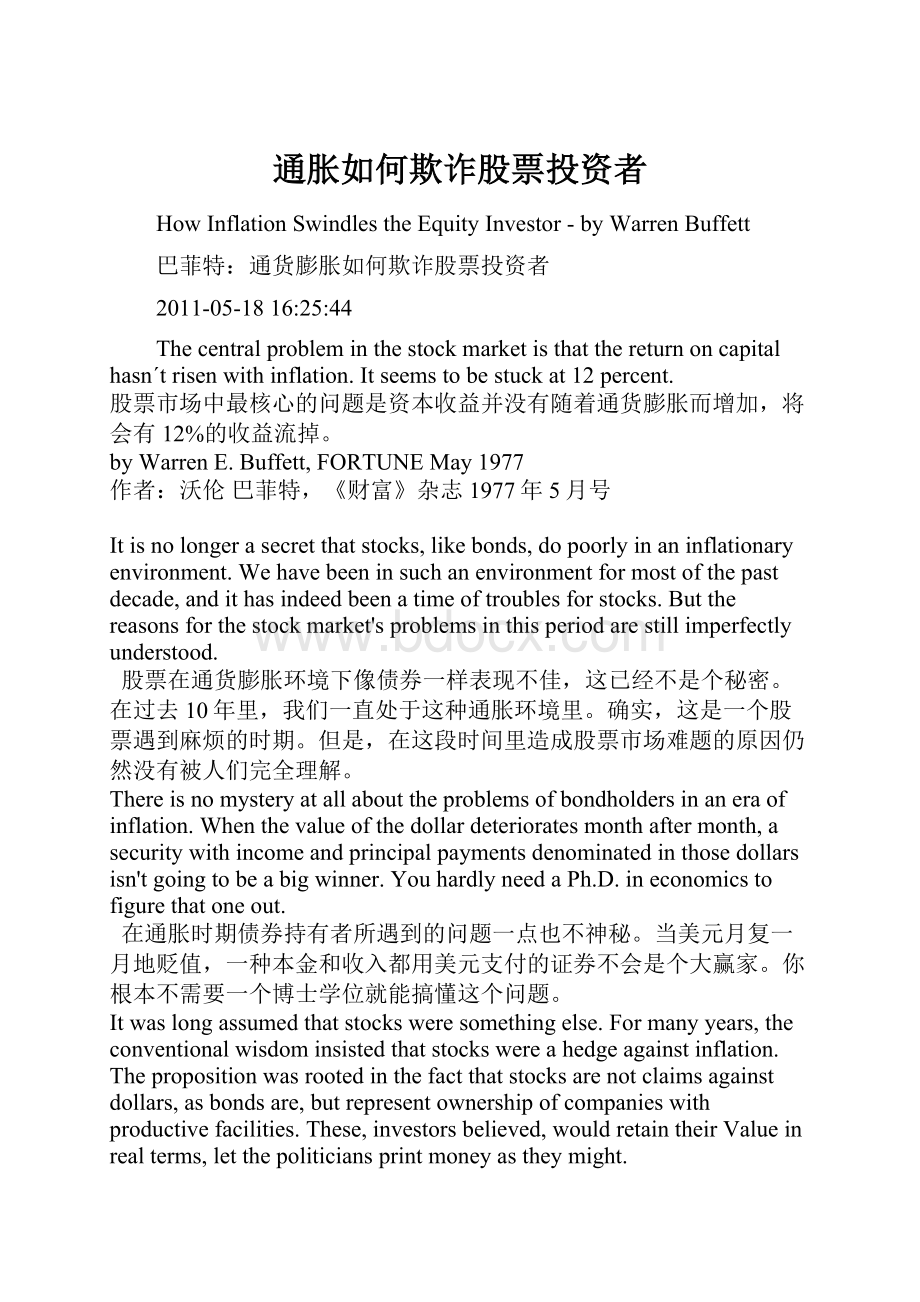通胀如何欺诈股票投资者.docx
《通胀如何欺诈股票投资者.docx》由会员分享,可在线阅读,更多相关《通胀如何欺诈股票投资者.docx(31页珍藏版)》请在冰豆网上搜索。

通胀如何欺诈股票投资者
HowInflationSwindlestheEquityInvestor-byWarrenBuffett
巴菲特:
通货膨胀如何欺诈股票投资者
2011-05-1816:
25:
44
Thecentralprobleminthestockmarketisthatthereturnoncapitalhasn´trisenwithinflation.Itseemstobestuckat12percent.
股票市场中最核心的问题是资本收益并没有随着通货膨胀而增加,将会有12%的收益流掉。
byWarrenE.Buffett,FORTUNEMay1977
作者:
沃伦巴菲特,《财富》杂志1977年5月号
Itisnolongerasecretthatstocks,likebonds,dopoorlyinaninflationaryenvironment.Wehavebeeninsuchanenvironmentformostofthepastdecade,andithasindeedbeenatimeoftroublesforstocks.Butthereasonsforthestockmarket'sproblemsinthisperiodarestillimperfectlyunderstood.
股票在通货膨胀环境下像债券一样表现不佳,这已经不是个秘密。
在过去10年里,我们一直处于这种通胀环境里。
确实,这是一个股票遇到麻烦的时期。
但是,在这段时间里造成股票市场难题的原因仍然没有被人们完全理解。
Thereisnomysteryatallabouttheproblemsofbondholdersinaneraofinflation.Whenthevalueofthedollardeterioratesmonthaftermonth,asecuritywithincomeandprincipalpaymentsdenominatedinthosedollarsisn'tgoingtobeabigwinner.YouhardlyneedaPh.D.ineconomicstofigurethatoneout.
在通胀时期债券持有者所遇到的问题一点也不神秘。
当美元月复一月地贬值,一种本金和收入都用美元支付的证券不会是个大赢家。
你根本不需要一个博士学位就能搞懂这个问题。
Itwaslongassumedthatstocksweresomethingelse.Formanyyears,theconventionalwisdominsistedthatstockswereahedgeagainstinflation.Thepropositionwasrootedinthefactthatstocksarenotclaimsagainstdollars,asbondsare,butrepresentownershipofcompanieswithproductivefacilities.These,investorsbelieved,wouldretaintheirValueinrealterms,letthepoliticiansprintmoneyastheymight.
一直以来,人们认为股票是不同的。
多年来,传统智慧坚持认为股票是对通货膨胀的对冲。
这个说法来源于一个事实,那就是股票不像债券一样是对美元的所有权,而是对有着生产设施的公司的所有权。
因此,股票投资者们相信,无论政客们如何印钞票,股票投资者仍然能保持他们投资的实际价值。
Andwhydidn'titturnbutthatway?
Themainreason,Ibelieve,isthatstocks,ineconomicsubstance,arereallyverysimilartobonds.
但是为什么实际上不是这么回事?
主要原因在于:
我认为股票在经济实质上非常类似于债券。
Iknowthatthisbeliefwillseemeccentrictomanyinvestors.Theywillimmediatelyobservethatthereturnonabond(thecoupon)isfixed,whilethereturnonanequityinvestment(thecompany'searnings)canvarysubstantiallyfromoneyeartoanother.Trueenough.Butanyonewhoexaminestheaggregatereturnsthathavebeenearnedbycompaniesduringthepostwaryearswilldiscoversomethingextraordinary:
thereturnsonequityhaveinfactnotvariedmuchatall.
我知道我的主张对很多投资者来说显得古怪。
他们马上就观察到债券的回报(利息)是固定的,而股票投资的回报(盈利)会每年变化极大。
这确实是事实。
但是,任何研究战后公司总体回报的人都会发现一个现象:
资本回报率实际上并没有变化那么多。
Thecouponissticky
停滞的息票
Inthefirsttenyearsafterthewar-thedecadeendingin1955-theDowJonesindustrialshadanaverageannualreturnonyear-endequityof12.8percent.Intheseconddecade,thefigurewas10.1percent.Inthethirddecadeitwas10.9percent.Dataforalargeruniverse,theFORTUNE500(whosehistorygoesbackonlytothemid1950's),indicatesomewhatsimilarresults:
11.2percentinthedecadeendingin1965,11.8percentinthedecadethrough1975.Thefiguresforafewexceptionalyearshavebeensubstantiallyhigher(thehighforthe500was14.1percentin1974)orlower(9.5percentin1958and1970),butovertheyears,andintheaggregate,thereturnonbookvaluetendstokeepcomingbacktoalevelaround12percent.Itshowsnosignsofexceedingthatlevelsignificantlyininflationaryyears(orinyearsofstableprices,forthatmatter).
战后10年,一直到1955年,道琼斯工业指数里的公司的资本回报率是12.8%。
战后的第二个10年,这个数字是10.1%。
在第三个10年,是10.9%。
财富500强(历史数据最早到50年代中期),这一个更大范围的数据显示了相似的结果:
1955-1965年资本回报率11.2%,1965-1975资本回报率11.8%。
这个数字在几个特殊年份里非常高(财富500强的最高值是1974年的14.1%)或者非常低(1958年和1970年是9.5%)。
但是,过去这些年,总体上,净资产的回报率持续回到12%的水平。
在通胀时期,这个数字没有显著超越这一水平。
在价格稳定的时期净资产的回报率也没有超越这一水平。
Forthemoment,let'sthinkofthosecompanies,notaslistedstocks,butasproductiveenterprises.Let'salsoassumethattheownersofthoseenterpriseshadacquiredthematbookvalue.Inthatcase,theirownreturnwouldhavebeenaround12percenttoo.Andbecausethereturnhasbeensoconsistent,itseemsreasonabletothinkofitasan"equitycoupon".
让我们先不把这些公司看成上市的股票,而是生产的企业。
让我们假定企业的所有人按净资产价值购买了这些企业。
如果是这样,这些企业的所有人自己的回报也是12%左右。
由于回报如此固定,我们有理由把回报看成“股票的息票”。
Intherealworld,ofcourse,investorsinstocksdon'tjustbuyandhold.Instead,manytrytooutwittheirfellowinvestorsinordertomaximizetheirownproportionsofcorporateearnings.Thisthrashingabout,obviouslyfruitlessinaggregate,hasnoimpactontheequity,couponbutreducestheinvestor'sportionofit,becauseheincurssubstantialfrictionalcosts,suchasadvisoryfeesandbrokeragecharges.Throwinanactiveoptionsmarket,whichaddsnothingto,theproductivityofAmericanenterprisebutrequiresacastofthousandstomanthecasino,andfrictionalcostsrisefurther.
当然,在现实世界里,股票投资者并不只是购买并持有。
相反,很多人在股票市场上反复买卖,试图战胜其它投资者,以获得公司盈利里面自己那部分的最大化。
这种争斗,从总体上来说是无效的,对股票及股票自身的盈利无影响,却减少投资者的收益。
因为这些活动会造成很高的摩擦成本,比如咨询费和交易费等。
一个活跃的期权市场的引入根本无法增加美国企业的生产率,只不过是产生了给这个赌场配置数以千计的人手的需求。
而摩擦成本则进一步升高。
Stocksareperpetual
股票是永久的
Itisalsotruethatintherealworldinvestorsinstocksdon'tusuallygettobuyatbookvalue.Sometimestheyhavebeenabletobuyinbelowbook;usually,however,they'vehadtopaymorethanbook,andwhenthathappensthereisfurtherpressureonthat12percent.I'lltalkmoreabouttheserelationshipslater.Meanwhile,let'sfocusonthemainpoint:
asinflationhasincreased,thereturnonequitycapitalhasnot.Essentially,thosewhobuyequitiesreceivesecuritieswithanunderlyingfixedreturn-justlikethosewhobuybonds.
实际上,在现实世界,股票投资者通常并不用净资产价格购买股票。
有时他们能在净资产价格之下购买。
但是大多数的情况下他们的购买价格要比净资产价格高。
这种情况下,就进一步增加了12%的资本回报的压力。
在后面的文章里我会进一步谈二者的关系。
现在,让我们关注主要的一点:
通货膨胀已经增加,但资本回报不变。
本质上,买股票的人得到的是内在的固定收益——和买债券的人一样。
Ofcourse,therearesomeimportantdifferencesbetweenthebondandstockforms.Foropeners,bondseventuallycomedue.Itmayrequirealongwait,buteventuallythebondinvestorgetstorenegotiatethetermsofhiscontract.Ifcurrentandprospectiveratesofinflationmakehisoldcouponlookinadequate,hecanrefusetoplayfurtherunlesscouponscurrentlybeingofferedrekindlehisinterest.Somethingofthissorthasbeengoingoninrecentyears.
当然,股票和债券有一些重要的不同。
首先,债券最终会到期。
债券可能需要等很长时间才到期,但是最终债券投资者能够重新谈判合同的条款。
如果目前和未来的通货膨胀率上涨使债券投资人旧的息票率显得不够,他可以拒绝再买。
除非目前的息票率提高,重新引起他的兴趣。
这种情况在近些年一直在持续上演。
Stocks,ontheotherhand,areperpetual.Theyhaveamaturitydateofinfinity.InvestorsinstocksarestuckwithwhateverreturncorporateAmericahappenstoearn.IfcorporateAmericaisdestinedtoearn12percent,thenthatisthelevelinvestorsmustlearntolivewith.Asagroup,stockinvestorscanneitheroptoutnorrenegotiate.Intheaggregate,theircommitmentisactuallyincreasing.Individualcompaniescanbesoldorliquidatedandcorporationscanrepurchasetheirownshares;onbalance,however,newequityflotationsandretainedearningsguaranteethattheequitycapitallockedupinthecorporatesystemwillincrease.
股票,与之相反,是永久的。
股票具有无限的到期日。
股票投资者只能接受美国企业的盈利,无论好坏。
如果美国企业注定获得12%的资本回报,这就是股票投资人必须接受的水平。
作为一个群体,股票投资者无法退出,也无法重新谈判。
从总体上说,他们的投入是增加的。
单个的公司可以被买卖或破产清算。
公司可以回购股票。
但是从总体来说,增发新股和未分配利润肯定会使锁定在公司系统里的资本增加。
So,scoreoneforthebondform.Bondcouponseventuallywillberenegotiated;equity"coupons"won't.Itistrue,ofcourse,thatforalongtimea12percentcoupondidnotappearinneedofawholelotofcorrection.
所以,债券在这点上占了上风。
债券最终会被重新谈判,股票的“息票”不会。
确实,在很长时间里,12%的息票率看起来并不需要很多调整。
Thebondholdergetsitincash
债券投资者拿的是现金
Thereisanothermajordifferencebetweenthegardenvarietyofbondandournewexotic12percent"equitybond"thatcomestotheWallStreetcostumeballdressedinastockcertificate.
这是另外一个债券与12%回报的“股权债券”的重要的区别。
股票就好像是穿着股票证书华丽外衣参加华尔街化妆舞会的一种新的债券-“股权债券”。
Intheusualcase,abondinvestorreceiveshisentirecouponincashandislefttoreinvestitasbesthecan.Ourstockinvestor'sequitycoupon,incontrast,ispartiallyretainedbythecompanyandisreinvestedatwhateverratesthecompanyhappenstobeearning.Inotherwords,goingbacktoourcorporateuniverse,partofthe12percentearnedannuallyispaidoutindividendsandthebalanceisputrightbackintotheuniversetoearn12percentalso.
通常情况下,债券投资者拿到现金息票。
他可以自己决定这笔现金最好的投资方式。
我们的股票投资者的“息票”-盈利,则与之相反,一部分被公司留用并重新投资,而且投资回报率完全取决于公司。
换句话说,公司的12%的年资本回报率一部分以现金方式发股息,剩下的重新投入盈取12%的回报。
Thegoodolddays
美好的旧日时光
Thischaracteristicofstocks-thereinvestmentofpartofthecoupon-canbegoodorbadnews,dependingontherelativeattractivenessofthat12percent.Thenewswasverygoodindeedin,the1950'sandearly1960's.Withbondsyieldingonly3or4percent,therighttoreinvestautomaticallyaportionoftheequitycouponat12percentviasofenormousvalue.Notethatinvestorscouldnotjustinvesttheirownmoneyandgetthat12percentreturn.Stockpricesinthisperiodrangedfarabovebookvalue,andinvestorswerepreventedbythepremiumpricestheyhadtopayfromdirectlyextractingoutoftheunderlyingcorporateuniversewhateverratethatuniversewasearning.Youcan'tpayfaraboveparfora12percentbondandearn12percentforyourself.
股票盈利的一部分重新再投入的特性,是好消息也是坏消息,这取决于那12%的回报到底有多诱人。
在1950年代和60年代早期,这的确是好消息。
当债券收益率只有百分之三或四的时候,能够有权自动把股票盈利的一部分再投入,取得12%的回报,具有极大的价值。
注意,投资人无法把自己的资金投资其他的东西而取得那12%的回报。
在这个时期,股票价格远超过净资产价格。
由于价格高涨,无论公司内在的回报率是多少,投资者都无法直接从公司的收益中获得回报。
这就好比年息12%的债券,如果你以远远超过票面价值的价格购买,是无法获得12%的回报的。
(老K注:
如果一个企业的长年ROE为12%,而你以远超类似债券的票面价值即1PB的价格购买,则无法获得12%的回报)
Butontheirretainedearnings,investorscouldearn22percent.Ineffert,earningsretentionallowedinvestorstobuyatbookvaluepartofanenterprisethat,:
intheeconomicenvironmentthanexisting,wasworthagreatdealmorethanbookvalue.
但是,投资者的存留收益可以获得22%的回报。
实际上,在当时的经济环境下,存留收益让投资者以净资产价格购买价值远超出净资产价格的企业。
Itwasasituationthatleftverylittletobesaidforcashdividendsandalottobesaidforearningsretention.Indeed,themoremoneythatinvestorsthough